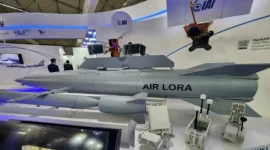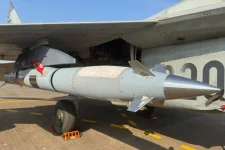- Views: 1K
- Replies: 12
The Indian Air Force (IAF) is reportedly evaluating two new advanced Israeli missile systems to enhance its capacity for deep-strike missions, which involve hitting high-value targets located far within enemy territory. This move comes after the reported operational success of the Rampage air-to-surface missile.
The systems under consideration are the 'Wind Demon' from Israel Aerospace Industries (IAI) and the 'ICE BREAKER' from Rafael Advanced Defense Systems, both designed to offer superior precision against well-protected land and sea targets.
The consideration for new platforms is said to be influenced by the performance of the supersonic Rampage missile, a long-range weapon that has demonstrated its ability to strike critical infrastructure with pinpoint accuracy.
The missile's effectiveness in penetrating modern air defence networks has prompted the IAF to explore next-generation technologies that can complement its existing arsenal and maintain a strategic advantage in the region.
IAI Wind Demon: A Flexible Precision Weapon
The Wind Demon, developed by Israel Aerospace Industries, is presented as a versatile air-to-surface cruise missile. Weighing approximately 140 kg, it has a strike range of over 200 kilometres. It is designed for easy integration onto various aircraft, including fighter jets and helicopters.The missile is equipped with sophisticated electro-optical and laser-homing seekers, enabling precise operations in all weather conditions, day or night.
One of its most significant features is its "person-in-the-loop" control, which transmits real-time video to a human operator who can make final adjustments before impact.
This capability, combined with its adaptable warhead designed for blast, fragmentation, or penetration effects, makes it suitable for a wide variety of missions against different target types.
Rafael ICE BREAKER: An Autonomous and Stealthy System
The ICE BREAKER, from Rafael Advanced Defense Systems, is a long-range, autonomous missile designed to independently neutralise high-value targets. Its compact and lightweight nature allows it to be launched from fighter jets, helicopters, ships, and ground-based launchers.A key strength of the ICE BREAKER is its ability to navigate in "GNSS-denied" environments, meaning it can find its target even if GPS satellite signals are blocked or jammed by enemy forces. The system achieves this using an advanced infrared seeker that matches the terrain below with pre-loaded images.
Furthermore, the missile features a very low observable (stealth) design and can fly at extremely low altitudes over land or sea, making it incredibly difficult for enemy air defence radars to detect and intercept.
It can also perform a "salvo attack," where multiple missiles strike a target simultaneously to overwhelm its defences.
Strategic Enhancement for the IAF
The evaluation of these systems marks a critical point in the IAF's ongoing modernisation efforts.The Wind Demon's real-time control offers tactical flexibility for engaging mobile or time-sensitive targets in contested airspace. In contrast, the ICE BREAKER's long-range autonomy and stealth features make it an ideal weapon for pre-planned strikes on heavily defended strategic locations like military command centres, airbases, and naval vessels.
The potential acquisition of either or both of these systems would significantly advance India's deep-strike capabilities beyond current platforms.
By investing in such state-of-the-art technology, the Indian Air Force aims to strengthen its deterrent posture and ensure its ability to maintain air superiority across the region.


